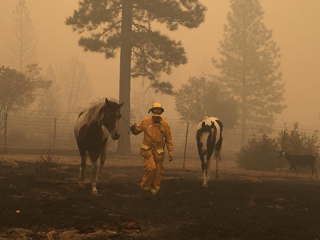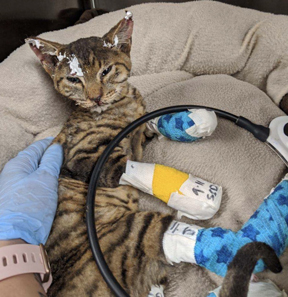Wildfire rescue - horses 320

North Valley Animal Disaster Group photo
North Valley Animal Disaster Group evacuation volunteer Rick Anderson led horses and a goat to safety Tuesday as wildfire tore through Berry Creek, California. The animals pictured were transported to the University of California Davis, School of Veterinary Medicine, where they are receiving care, having been exposed to toxic fumes and smoke.
As the wildfires scorching millions of acres of the American West begin to yield to firefighters and cooler weather, smoke lingering in the atmosphere continues to endanger the health of those who breathe it, including pets, livestock and wildlife.
Wildfire smoke — a mix of gases and fine particles from burning vegetation, buildings and various materials — is a public health hazard, experts say, and animals with cardiovascular or respiratory disease are at particular risk for illness. Tiny particles less than 10 micrometers in diameter are the most dangerous, the U.S. Environmental Protection Agency reports, because they can settle deep in the lungs and travel into the bloodstream, aggravating asthma and causing heart problems.
Officials say it's too early to know the extent of damage caused by the West Coast fires, believed to have started in late August, many by lightning. At least 28 major fires have been identified during recent weeks in California, Idaho, Oregon and Washington, killing dozens of people and countless animals. Some have been contained; others, including the Riverside Fire in Clackamas County, Oregon, continue to burn.
With the federal air quality monitoring site Airnow.gov rating the air in cities such as Portland and Seattle "unhealthy," Dr. Michelle Hawkins of the University of California Davis, School of Veterinary Medicine fears what might happen to coastal bird populations and migrators, with large die-offs being reported by biologists, who believe the smoke plumes are causing birds to lose their way. "It’s migration season right now," Hawkins said, and some of the birds might be disoriented by the smoke and the particulate matter.
Toxicants could be playing a role, too. Birds are particularly susceptible to chronic disease and secondary infections from exposure to wildfire smoke, said Hawkins, a professor of avian and exotic animal medicine in the Department of Veterinary Medicine and Epidemiology. Signs of illness — breathing hard, lethargy and tail bobbing — can show up as many as three weeks after exposure.
Or, strangely, not at all. Hawkins said of the hundreds of birds plucked from fire regions by the UC Davis Veterinary Emergency Response Team (VERT) and brought in for care, most show no signs of respiratory distress. The team, composed of students, veterinary technicians and veterinarians, are deployed to care for animals whenever wildfire breaks out in Northern California.
Since mid-August, VERT volunteers have rescued and/or field-treated roughly 700 animals from the North Complex fires in Butte County. Of 315 animals taken to UC Davis for treatment, at least 60 have been birds, including pheasants, chickens and waterfowl, many exposed to hazardous pollutants in the air.
Curiously, Hawkins said, "Very few show open-beak breathing, and we don't know why that is."
To solve the mystery of why birds show few clinical signs that they're struggling to breathe, Hawkins aims to gather field data for a future study. "It's just so astounding to me that we've seen so little overt signs of illness," she added. "More research is needed to evaluate what particulate matter in the air does to these animals."
In the field, VERT volunteers have treated burned bears, bobcats and plenty of backyard wildlife and farm animals. But in terms of wild birds, "it's not very common that we're getting to them," Hawkins said. "You have to go in deeper to find them because they're not often on people's property."
Many wild birds are thought to be lost to the charred wilderness, dying away from the scenes of razed property and the path of rescue workers. Nine endangered California condors are unaccounted for after fire destroyed pens and facilities used by conservationists to restore their populations. "We don't know what's happened to them yet," Hawkins said.
Burned kitty 288

Butte Humane Society photo
Veterinarians and staff at Butte Humane Society in Chico, California, are caring for feline fire victims, some with wounds deep enough to expose bone. All have done well with treatment, reports Dr. Mariana Turner, chief medical officer.
Some large birds are spotted too late. A sick and injured golden eagle brought Sept. 8 to UC Davis by a Good Samaritan died the same day. "It had been out there so long, with smoke inhalation and starving," Hawkins said with regret. "It was weak because there's no food supply, no rodents. They were all killed in the fire."
Evacuated but staying close to help patients
Dr. Mariana Turner, chief medical officer at the Butte Humane Society, says 16 cats rescued from fire zones are recuperating at the facility in Chico, California.
This isn't the first time Butte Humane has provided treatment and refuge for fire victims. The practice served as rescue center during the deadly Camp Fire, which decimated nearby Paradise and other ridge towns in the Sierra Nevada foothills in 2018.
This time around, Turner says the injuries she's treating aren't as extensive, though some patients have burns deep enough to expose bone. Reflecting, she said: "I think that's either because rescuers are sending us less critical cases this time, or more animals are perishing or euthanized in the field. Our patients this week have been doing really well."
So is Turner, who kept her perspective positive more than a week after evacuating the 10-acre property she owns near fire-ravaged Feather Falls, her extended family and pets in tow. Rumor has it that her home is still standing, but there's been no official word. With hot spots ongoing, residents and investigators can't get into the area.
"I'm hoteling it right now," she said, her tone pragmatic. Turner sent her daughter, a 6-year-old first-grader in the throes of remote learning, and her mother and uncle, to stay with relatives in the Bay Area. "My mom has asthma. I needed to get them out of here."
Turner's husband, meanwhile, is staying at the hotel with her in Chico. "His job right now is to find us housing and getting together all the insurance stuff," she said, "and I'm just thankful for that. I feel like, for me, my biggest thing is that I don't have my glasses; I left them behind in the house. There are people who don't have a place to live right now."
AVMA offers guidance
Animals exhibiting signs of illness due to smoke inhalation often will cough and have asthma-like symptoms, breathing rapidly with their mouths open. They may stop eating, become fatigued or have discharge from the eyes and nose. "If any of your animals are experiencing any of these signs, please consult your veterinarian," the American Veterinary Medical Association says in a post providing tips for protecting pets and livestock.
When air quality is poor, the AVMA advises keeping pets indoors with the windows shut, letting them out only for brief bathroom breaks. Exercise pets when dust and smoke have settled, and have a pet evacuation kit ready in case of an emergency.
Livestock often can't be kept indoors, so the AVMA advises limiting their exercise when smoke is visible. "Especially don't require animals to perform activities that substantively increase their airflow into and out of the lungs," the AVMA says. Another tip: Have a livestock evacuation plan ready. "If you don't have enough trailers to quickly transport all of your animals, contact neighbors, local haulers, farmers, producers, or other transportation providers to establish a network of reliable resources that can provide transportation in the event you need to evacuate your animals," the AVMA says.
Other suggestions:
- Provide animals with plenty of fresh water.
- Limit dust exposure by feeding low-dust or dust-free feeds.
- Mist livestock holding areas with water.
- Plan to give livestock four to six weeks to recuperate after air quality returns to normal.
- Make sure barns and structures are stable, promptly remove dead trees and clear away brush to maintain a defensible space around buildings.